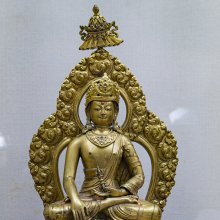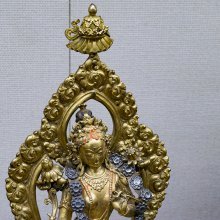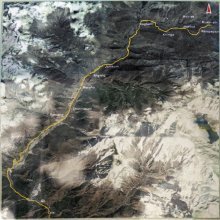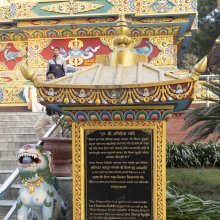Lagi, Lagī, Lāgi: 2 definitions
Introduction:
Lagi means something in Marathi, Hindi. If you want to know the exact meaning, history, etymology or English translation of this term then check out the descriptions on this page. Add your comment or reference to a book if you want to contribute to this summary article.
Images (photo gallery)
(+8 more images available)
Languages of India and abroad
Marathi-English dictionary
Source: DDSA: The Molesworth Marathi and English Dictionarylagī (लगी).—f (lagūḍa S through H) A staff or pole with a banner or little flag at one end. It is carried before great men in their processions, and is used in the lance-exercise. 2 The beam laid along the heads of a row of posts or pillars.
--- OR ---
lāgī (लागी).—a (lāgaṇēṃ) That is connected with; that has dependence upon, pertinency, suitableness, or other relation unto or with. Ex. hā dhōtarajōḍā tumacē lāgī āhē tumhī ghyā.
Marathi is an Indo-European language having over 70 million native speakers people in (predominantly) Maharashtra India. Marathi, like many other Indo-Aryan languages, evolved from early forms of Prakrit, which itself is a subset of Sanskrit, one of the most ancient languages of the world.
Hindi dictionary
Source: DDSA: A practical Hindi-English dictionaryLagī (लगी):—(nf) longing, ardent desire, what has been taken to heart; —[bujhanā] one’s longing to be fulfilled; —[burī hotī hai] the flame of love once ignited must have its toll, love leaves none unscathed; —[chūṭatī nahḹṃ] the inefection of love persists; the heart once lost can never be retrieved.
...
See also (Relevant definitions)
Starts with: Lagi-drammah, Lagilai, Lagili, Lagilid, Lagim, Lagima, Lagimbhagim, Lagina, Lagini, Laginu, Laginyabaila, Lagiparai, Lagiparnu, Lagira, Lagisu, Lagita, Lakini, Lakiri.
Ends with (+40): Addalagi, Agalagi, Amalaki, Balagi, Ballagi, Cakalavallaki, Callaki, Cemmilaki, Cevvilaki, Chelagi, Cilaki, Davanamalagi, Dharanici Mulagi, Dillagi, Ekalagi, Haatlagi, Hagabalagi, Halabalagi, Halagi, Hamssidillagi.
Full-text: Bheti, Lagi-drammah, Dhuna, Langula, Dhukadapukada, Terittunatai, Dhun, Langa, Lag, Niyata, Langala, Picha, Niyat, Kotpu, Lagana, Vinai, Dam, Dama, Hath, Hatha.
Relevant text
Search found 5 books and stories containing Lagi, Lagī, Lāgī, Lāgi, Laagi; (plurals include: Lagis, Lagīs, Lāgīs, Lāgis, Laagis). You can also click to the full overview containing English textual excerpts. Below are direct links for the most relevant articles:
Chaitanya Bhagavata (by Bhumipati Dāsa)
Verse 2.6.30-031 < [Chapter 6 - The Lord’s Meeting with Advaita Ācārya]
Verse 1.7.177 < [Chapter 7 - Śrī Viśvarūpa Takes Sannyāsa]
Verse 3.10.93 < [Chapter 10 - The Glories of Śrī Puṇḍarīka Vidyānidhi]
Bhajana-Rahasya (by Srila Bhaktivinoda Thakura Mahasaya)
Text 26 < [Chapter 1 - Prathama-yāma-sādhana (Niśānta-bhajana–śraddhā)]
Text 22 < [Chapter 6 - Ṣaṣṭha-yāma-sādhana (Sāyaṃ-kālīya-bhajana–bhāva)]
Text 27 < [Chapter 6 - Ṣaṣṭha-yāma-sādhana (Sāyaṃ-kālīya-bhajana–bhāva)]
Folk Tales of Gujarat (and Jhaverchand Meghani) (by Vandana P. Soni)
Chapter 35 - Vikram and Khapro < [Part 5 - Rang Chee Barot]
Chapter 4 - Suhini-Mehar (Love stories of other regions) < [Part 1 - Saurashtra ni Rashdhar]
Folk Tradition of Bengal (and Rabindranath Tagore) (by Joydeep Mukherjee)
Shri Gaudiya Kanthahara (by Srila Bhaktisiddhanta Sarasvati)





